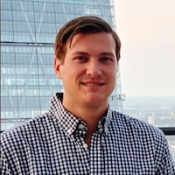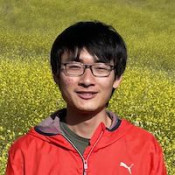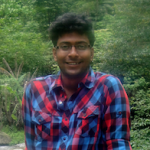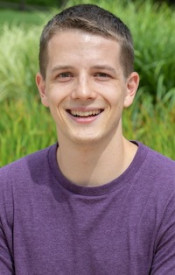Five Early-Career Researchers Honored with NERSC Achievement Awards
November 9, 2023
By Elizabeth Ball
Contact: cscomms@lbl.gov
At the November NERSC User Group monthly meeting, five NERSC users were honored with NERSC Early Career HPC Achievement Awards. The annual awards recognize early career researchers who have made significant contributions to scientific computation using NERSC resources.
The awardees were cited for their pioneering work in a variety of fields supported by the U.S. Department of Energy (DOE) Office of Science, including materials science, cosmology, and computational research.
Two awardees, Youssef Elmougy and Anthony Kremin, were honored for Innovative Use of High Performance Computing, while Fangzhou Zhao, Bikash Kanungo, and Kyle Bushick were honored for High-Impact Scientific Achievement.
Youssef Elmougy

Youssef Elmougy
Elmougy, a Computer Science Ph.D. student at the Georgia Institute of Technology and a summer 2023 graduate research assistant at Berkeley Lab, was recognized for introducing an innovative approach to achieve large-scale asynchronous graph processing. During his internship at Berkeley Lab, he worked in the Performance and Algorithms Research lab within the Applied Mathematics and Computational Research Division.
“Youssef’s work demonstrated real-world problem-solving capacity using high-performance computing innovatively,” said Akihiro Hayashi, Elmougy’s co-advisor at Georgia Tech, of the work he was nominated for. “Youssef has extensively used NERSC resources to profile and optimize runtime systems and distributed graph applications, as well as introduce new algorithms and applications that utilize the full capacity of HPC resources, such as those presented by the Perlmutter supercomputer.” Hayashi noted that his accomplishments are especially impressive since he achieved them in his first year as a Ph.D. student.
In addition to the quality of his work, Elmougy’s other Georgia Tech co-advisor Vivek Sarkar also highlighted his dedication to team science, an important value of the NERSC community. “Youssef is a dedicated team player,” said Sarkar in a letter of support. “Rather than only focusing on his work, he is very happy to help anyone in need.”
Anthony Kremin

Anthony Kremin
Kremin, a postdoctoral dark energy researcher in the Physical Sciences area at Berkeley Lab, was honored for developing and implementing a pioneering approach to enable data processing from the Dark Energy Spectroscopic Instrument (DESI), helping fulfill DESI's mission to construct the world’s largest 3D map of the universe and allow fundamental tests of cosmological physics.
“Dr. Kremin’s pipeline operations serve as a model for other experiments,” said Berkeley Lab Physics Division Cosmology Group Lead David Schlegel in a letter of support for Kremin. “Most projects of a comparable scale only produce their science-quality reductions weeks, months or years (!) after the data are taken.” Kremin’s approach transfers raw telescope data to NERSC each night and produces science-grade data reductions each morning, an example of the superfacility concept pioneered at Berkeley Lab and an achievement known within the DESI team as “redshifts by breakfast.”
Colleagues also noted Kremin’s commitment to team science and putting the needs of the project first: “Dr. Kremin is one of the few postdoctoral researchers who is using high performance computing at NERSC for the benefit of the entire DESI collaboration,” said University of Utah professor and DESI co-spokesperson Kyle Dawson.
Fangzhou Zhao

Fangzhou Zhao
Zhao, a computational physicist at UC Santa Barbara working on electronic, optical, and topological properties of materials, was recognized for developing a first-principles computational formalism to calculate the rate of trap-assisted Auger-Meitner (TAAM) recombination. The result is a breakthrough that could eliminate efficiency barriers in LEDs and other common optoelectronic devices. Zhao earned his Ph.D. in physics from UC Berkeley in 2021.
Zhao’s research identifies a novel mechanism for defect-mediated recombination, a mystery scientists have been hypothesizing about since the 1950s.
“His latest work, which was made possible with the resources at NERSC, is a major breakthrough in the field of optoelectronic devices of wide-bandgap materials,” said UC Berkeley physics professor Steven G. Louie in a letter of support. “The work represents a major breakthrough for the field, providing a microscopic understanding of a physical phenomenon that has long eluded explanation, as well as a general methodology and computer code to compute its quantitative behavior from first principles. Both are essential for further advances in the design of new devices with high efficiency.”
Bikash Kanungo

Bikash Kanungo
Kanungo is an assistant research scientist at the University of Michigan; he was recognized for developing a data-driven approach to improved exchange-correlation functionals in density functional theory (DFT), a method commonly used in chemical sciences, materials sciences, and other fields, via an accurate solution to the inverse DFT problem. His work was integral to research that has also been nominated for the 2023 ACM Gordon Bell Prize. Kanungo earned his Ph.D. in Mechanical Engineering from the University of Michigan in 2019.
According to colleagues, Kanungo’s work used NERSC resources to develop a computational framework that moves researchers closer to a more accurate exchange-correlation functional, a question for nearly three decades.
“The problem that Kanungo has addressed is focused on discovering the form of the exchange correlation functional, which is a central piece of DFT – itself the workhorse framework for fundamental understanding and prediction in computational materials physics,” said Krishna Garikipatri, professor and director of the Michigan Institute for Computation Discovery & Engineering.
Kyle Bushick

Kyle Bushick
Bushick, a P.h.D student at the University of Michigan pursuing a degree in Materials Science and Engineering and Scientific Computing, was recognized for developing a novel computational methodology to calculate the Auger-Meitner recombination rates in silicon using predictive atomistic calculations, including the ability to robustly include interactions between electrons and atomic vibrations. Bushick is currently a DOE Computational Science Graduate Fellow.
Bushick’s work focuses on developing and employing first-principles calculations to study quantum processes in semiconductor materials with the aim of improving our understanding of the microscopic mechanisms that govern material properties.
“A-M recombination is the most important intrinsic recombination mechanism in silicon and it’s actually surprising that Kyle’s work is the first to simulate the phonon contributions with modern high performance computing power,” said David L. Young, Group manager of the High Efficiency Crystalline Photovoltaics Group at the National Renewable Energy Lab. “World-record silicon solar cells are currently limited by A-M recombination, so having a first-principles understanding of the mechanism may allow material scientists and device engineers to design around the limitation.”
About NERSC and Berkeley Lab
The National Energy Research Scientific Computing Center (NERSC) is a U.S. Department of Energy Office of Science User Facility that serves as the primary high performance computing center for scientific research sponsored by the Office of Science. Located at Lawrence Berkeley National Laboratory, NERSC serves almost 10,000 scientists at national laboratories and universities researching a wide range of problems in climate, fusion energy, materials science, physics, chemistry, computational biology, and other disciplines. Berkeley Lab is a DOE national laboratory located in Berkeley, California. It conducts unclassified scientific research and is managed by the University of California for the U.S. Department of Energy. »Learn more about computing sciences at Berkeley Lab.







